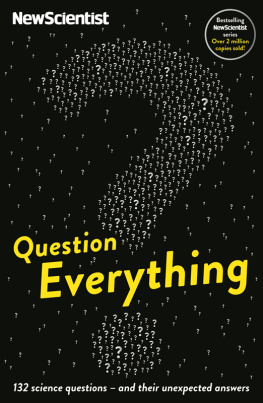13. The Rest
Stop talking
What parameters, if any, limit the number of different words available to us in English (or any other language)? Are we near to running out of words?
Jonathan Cope
London, UK
The existence of polyglots suggests that the average person is far from running out of storage space in the brain. And while there are major structural constraints on word numbers, they too leave lots of room for expansion.
First, there is some effect from the number of distinct sounds (phonemes) in a language. Languages with fewer phonemes have some tendency to have longer words.
English has about 40 phonemes and many short words, while Hawaiian, with only 13 phonemes, has many words of three or four syllables. Any language can increase the potential size of its vocabulary by using longer words.
Much more limiting than the number of phonemes are a languages phonotactic patterns the constraints on possible sequences of phonemes. In English, words can begin with sequences like sp or st, but in Spanish they cannot hence the vowel at the beginning of Espaol. In Greek, words can begin with sequences like pn or ps, but in English this is not permissible, so we pronounce Greek loan words like pneumatic and psychology without the p.
Even so, we are a long way from using up all the permitted shapes: AIDS, fax and ROM are all recent additions, but snizz, whask and literally thousands of other possible English sequences are all unused.
D. Ladd
Department of Linguistics
Edinburgh University, UK
Assuming that we strictly limit ourselves to only consonantvowelconsonant forms and do not include such extras as tones and stress, the following provides a generous lower boundary to the number of words available in English.
There are more than 50 possible initial consonants (including combinations such as tr and sk). There are more than 10 distinct vowel sounds. Consider: rad, raid, red, rid, ride, rude, rod, reed, road, and add in non-words such as roid (void) and rould (should).
There are more than 40 terminal consonants (including rt and lk). This means that there are in excess of 20,000 (50 x 10 x 40) single syllables. If we limit ourselves to using only two syllables per word we would still have more than 400 million words to play with.
Francis Glassborow
Oxford, UK
Numerical differences
On a trip to Saudi Arabia I expected to find Arabic numerals in use (as we call them in the western hemisphere). Arabian numerals are entirely different, so how did ours become known as Arabic?
Jerry Kluza
Brookfield, Wisconsin, US
Both sets of numerals originally come from India. Although the numerals used by Europeans, Americans, and much of the international community are referred to as Arabic numerals they were not originally created by the Arabs. This misnomer originated in the 9th century when a manuscript on arithmetic which had been written in India was translated soon after into Arabic. Merchants then carried this book to Europe where it was subsequently translated into Latin.
Because the source for the Latin translation was an Arabic text, the numerals were falsely ascribed to the Arabs. This is where the confusion arose: the numerals came from India and are not Arabic at all.
The present set of Arabic numerals evolved over the early centuries but has changed little since the advent of printed books in around 1445. Curiously the numerals 4, 5, 6 and 7 underwent the most changes from the original script. The numerals used in Arabic countries (and Iran) have undergone minor changes from the original Hindu manuscript.
Paul Marselian
San Diego, California, US
Indians made two crucial advances in number systems. They introduced place values and a special symbol for zero.
The value of these innovations can readily be experienced by anyone trying to do simple arithmetic with non-place-value systems, like Roman numerals. Place-value numeration allows the mathematician to arrange addition in columns and to carry over numbers from the ones to the tens, or from the tens to the hundreds columns. This is very difficult to do with Roman numerals.
It is interesting that all Indic scripts are written from left to right (like English), and so are the numbers. Arabic writes words from right to left. Yet its numbers, being borrowed from those used in India, are written from left to right. Many speakers of Arabic are unaware of the reason why their numbers are written in the opposite way to their words, even though they may use them every day.
William Wolf
Chicago, Illinois, US
We did indeed get our numerals from the Arabs, who had adopted them originally from India. In Arabic they are therefore called al-arqm al-hindya, which translates as the Indian numerals.
Philip Stewart
Oxford, UK
The numerals that we use today are called Arabic because Europeans adopted them from the Arabs. However, they are Indian in origin.
According to popular tradition the Arabic numerals were invented soon after the start of the 6th century by the Indian astronomer Aryabhata. They made up the first fully positional numeral system, in which the numeral 1 could stand for one, a hundred or a thousand, depending on its position in the number.
It was not the first use of a symbol for zero, however. This occurs in late Babylonian numerals. Aryabhata is said to have been inspired by the sand abacus, a device for multiplying numbers by making marks in a grid drawn on sand, in which the position of the marks is significant.
The Arabs brought Indian scholars to Baghdad in 771 to teach them how to use the new numerals, which they originally called huruf al-ghubar, or sand letters, after the sand grid mentioned above.
Europeans started to use them widely after 1202, when Leonardo of Pisa explained and detailed their use in his Book of the Abacus.
Ralph Hancock
London, UK
In 1299, the city of Florence in Italy issued a decree prohibiting the commercial use of Arabic numerals because they were easily falsified. For example, a 0 could easily be changed to a 6.
Ron Webb,
Macclesfield, Cheshire, UK
The precise glyphs that are used for the digits have varied considerably over the centuries. Those used in Europe were stabilised by the selection William Caxton used for his printing press.
Prior to that there was considerable variation, particularly for the glyphs that were used for 4 and 5. For a long time the glyph we now use for four would have been considered to represent five.
It is not surprising that the actual glyphs used in Arabic- speaking countries are very different from those that we use now, and these differences can be very confusing, especially to the unwary.
The traffic speed limit on the bridge running between Khartoum and Omdurman in Sudan used to be posted in both English and Arabic. The limit was 10 miles per hour, but apprehended drivers frequently defended themselves on the grounds that they had never exceeded the 15 miles per hour that they had seen on the signpost. This is because the glyph we use for zero is very similar to that used in Arabic for five.
To add to the confusion, the Arabic glyph for zero is also very close to the raised point that we traditionally use as a decimal point.
Francis Glassborow
Oxford, UK
Roman division
How did the Romans express fractions?
John Chappell
Grassington, North Yorkshire, UK
In scientific work, which was always written in Greek, the Romans used sexagesimal fractions, like those used for angles and time, expressed by Greek literal numbers and positional notation.
For everyday uses, common fractions were always used, often spelled out, such as tribus duas partes (with thirds two parts) for . The solidus (the line in a fraction between the two numerals), or any implied division, was never used. However, abbreviations were often used if necessary. The most common were S or SK (
Next page









